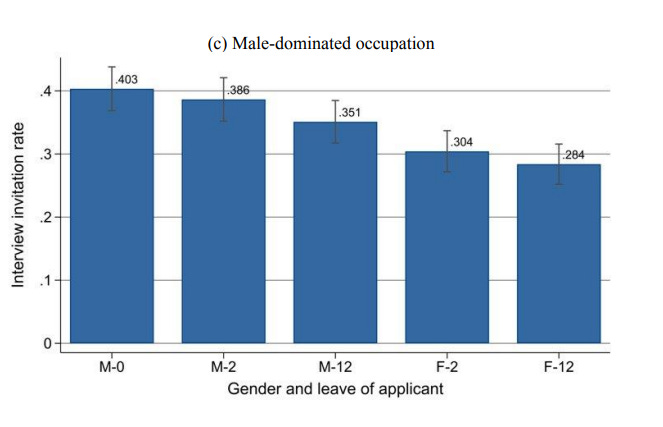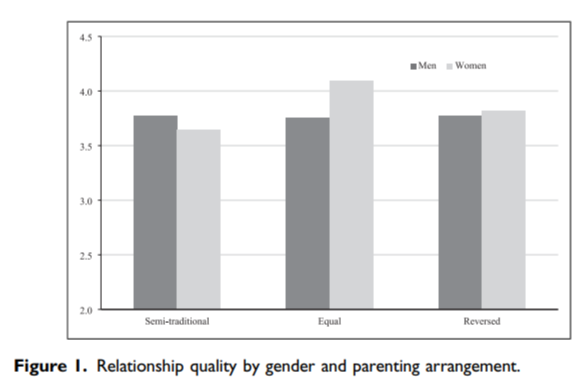Maybe Gender Equality is the Key to Marital Bliss After All, and Other Interesting New Research
Gender discrimination goes both ways; The connection between neighborhood “belonging” & fertility; The kin-poor rich; Stop pretending remote work isn't great; The rise of female-headed households.
Hello Everyone,
Before I get into the newsletter, I have a request: I’d love to hear any thoughts readers have about the length or format of the newsletter thus far. Is it too long? Does it cover too many studies? Are the descriptions too wordy? I aim to please and am open to feedback. (Also, I am pretty sure that while I was up late last night writing this newsletter, I felt the baby kick for the first time—I assume because he or she gets really amped about family policy like I do. Or maybe they just wanted me to go to sleep.)

The Environmental Upsides of Demographic Collapse (??)
Before I explain the findings of this study, I want to clarify that I’m not particularly well-versed in research on environmental issues. Most of my interest in demographic trends centers on declining fertility and the possible consequences thereof. That said, even as birth rates fall around the globe, the earth’s population will continue growing for a few more decades. And there are plenty of people concerned that the planet won’t be able to sustain its rising numbers. This paper investigates how all these new people will affect demand for food, water, and other resources, as well as energy and emissions, and comes down in a fairly…er…optimistic place. Evidence from the past 60 years suggests we shouldn’t worry too much about food and nonrenewable resources: Food production has reliably outpaced population growth. Things look a little dicier when it comes to water and greenhouse gas emissions. But according to their calculations, population growth won’t impact energy and carbon emissions much in the coming decades. That’s because the sizeable population declines expected in high income, high emissions countries like China will offset the impact of population growth in lower income countries. Which is…good?
Maybe Gender Equality is the Key to Marital Bliss After All
One of the weirder battles in the Mommy Wars centers on which moms are the most miserable. Some are convinced that SAH moms are miserable; others think that those in a dual-earner set-up are making themselves unhappy by resisting their natural, God-given roles in the name of feminism. This study gives a point to team feminism. The authors examined how relationship quality, satisfaction, and well-being varies among couples with different divisions of labor: semi-traditional (in which the mother is the primary caregiver and makes less than 40% of the family income), equal (in which partners share childcare and work hours roughly equally and contribute approximately 50% of the family income), and role-reversed (in which the father is the primary caregiver and makes less money). Long story short, women in equal arrangements had the highest relationship quality, relationship satisfaction, and life satisfaction; women in more traditional set-ups had the lowest.

I don’t know exactly what to take away from this study. I’m certainly pro-dividing-work-equally, but I tend to be fairly agnostic about how couples actually do that. I don’t come close to earning half of our household income, and I work less and do more childcare than my husband, but I think we’ve got a pretty solid set-up—and a pretty equal one! By that I mean that if you were to take all the work, paid or unpaid, that needs to get done in order to keep the kids alive and the household running, I think each of us are doing roughly equal shares. I would certainly like to make more money (on that note, please consider becoming a paid subscriber :)), but I can think of a lot of ways to do that that would not in fact make me happier.
It makes me wonder if the category of semi-traditional couples here is a bit too broad. Presumably, it includes situations like mine (breadwinning dad super involved in the home) along with those in which the man is working 40 hours a week at his job and his wife is working 168 hours a week running the home and caring for the kids without any help, which would be an insane division of labor. On top of that, if I’m reading the study correctly, it looks like the couples in semi-traditional arrangements had more and younger kids, and well, having lots of youngish kids can be tough on a relationship.
Are the Elderly Rich Kin-Poor?
If you are reading this newsletter, you are likely already aware that the population is aging—that is, that the ratio of old to young is rising—which presents some challenges when it comes to eldercare. All around the world, including countries with robust subsidized eldercare systems, the elderly are heavily reliant on informal care from kin. In other words, even though the modern economy gives us a lot of reason to hesitate about getting married or having kids, kin are still an asset in old age. Procreating your way to a retirement plan isn’t as reliable an option as it once was, and yet older people without kids or partners have the biggest shortfalls in care. A new study adds to this discussion by looking at how kin networks vary among elderly folks of different socioeconomic levels in a bunch of different countries. Broadly, they found that in most countries, including America, rich folks tend to have fewer but better educated descendants, and are more likely than the poor to have a partner or living parents. I suppose the question this study raises is whether it’s better to have fewer, higher educated kin and a living partner, or if there’s strength in numbers.
Gender Discrimination in the Labor Market is a Two-Way Street
The point of this study was to figure out whether employers (in Germany) in various occupations discriminate against dads who take paternity leave—and they do, but there are some interesting nuances to the findings. In the female-dominated and gender-neutral occupations analyzed, fathers who took leave were no less likely to get an interview invite than fathers who didn’t. In the male-dominated occupation, fathers who took longer leaves (12 months, rather than 2 or none) were indeed less likely to get a call-back. Meanwhile, leave-taking had no impact on whether women got an interview invite in any of the jobs. (This contrasts somewhat with another recent study, which found that Australian mothers who forgo paid parental leave received pay premiums). But the authors also found that, regardless of leave taking, men were less likely than women to get an interview offer in female dominated industries (in case you’re wondering, job experience was held constant). In male dominated industries, women were less likely than men to get an interview. In other words, gender discrimination in the labor market goes both ways: girls discriminate against boys and boys against girls.

The Global Rise of Female-Headed Households
Pretty much every country in the world asks households to designate one member as its head. Historically, that person was usually a man, but according to this new study, female headship is rising across the globe, though at different rates in different countries and for different reasons. In the U.S., female headship rose from 32% in 1990 to just about 50% in 2015. In some places, like South Korea, the rise of female household heads is almost entirely explained by the fact that women are increasingly likely to live without men; in Korean households with both men and women, men are still in charge. But in other places, including America, the emergence of female-headed households can’t be chalked up to only the absence of men. In other words, American women are increasingly likely to be designated the head of a household, even when they are living with a male partner or other man.
The Connection Between Neighbourhood “Belonging” and Fertility
Fertility is falling and no one knows why, but those searching for explanations are getting creative. This study examined the relationship between neighborhood “belonging” and one’s likelihood of becoming a parent, with interesting results! One thing that’s sort of tricky about this is that people often move in anticipation of having a child, so those who have moved recently are actually more likely to go on to have a child (even though moving tends to rupture social ties and toss someone into an unfamiliar environment). That said, the authors find that among “recent movers,” those with a greater sense of belonging to the neighborhood are (slightly) more likely to go on to have a child. The relationship between belonging and likelihood of having a child is particularly strong for those living in large urban areas, who are on the whole less likely to have a child at all.

Stop Pretending That Working from Home Isn’t Great
There is an ongoing debate about whether or not remote work helps or hurts an individual’s work-life balance. The latest Survey of Working Arrangements and Attitudes (SWAA) found that among full-time employees, those who work from home report the lowest levels of burnout—this, despite the fact that a previous survey found that they were the most likely to work outside of traditional hours. This is a curious pair of findings: working from home does allow work to bleed into home life, and yet, those working from home are less burned out for it. As a mom who works from home, this finding doesn’t really surprise to me: remote work certainly makes it a lot easier for me to move fluidly between domestic and non-domestic tasks. It is the reason that I am able to sell Christmas Disco raffle tickets all week at my daughter’s school.
This is nuanced, of course. There are definitely reasons to be wary about what people, and women in particular, sacrifice by working from home. But the thing the remote work haters don’t want to contend with is that “work” and “home” are very poorly integrated in the traditional in-person set-up. Straddling the responsibilities of each world is a massive headache, and a great deal of it stems from the physical distance between the two. I’m not saying remote work is the only solution here. I would love for it to be easier for people to work near home, so that working from home wasn’t so necessary. But barring that, it seems silly to pretend working from home isn’t an attractive compromise for a lot of people.







Just popping in to say I like the number of articles covered and the length! Wouldn’t mind a bit more on each, but the current format is great for me.
The thing that's essential to understand about which marriages are happiest is a very surprising fact. In most female breadwinner marriages fathers do less childcare and housework than their wives. These marriages are pretty terrible, on average. These men, on average, are more likely to beat and cheat on their wives than male breadwinners.
The study excluded those marriages, seemingly, and only looked at female breadwinner marriages where the fathers are the primary caregivers. That those marriages would be less happy than equal marriages or semi-traditional marriages makes intuitive sense to me. Equal marriages probably have the least abuse and semi-traditional marriages probably have the most.